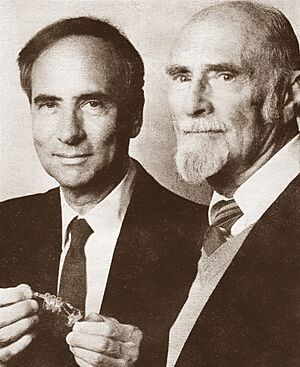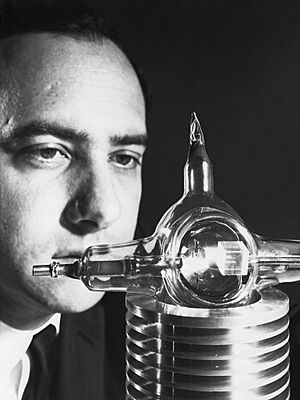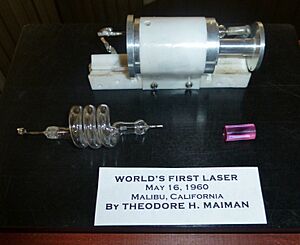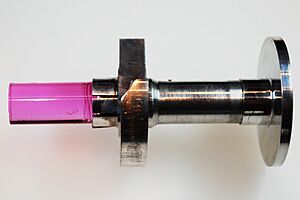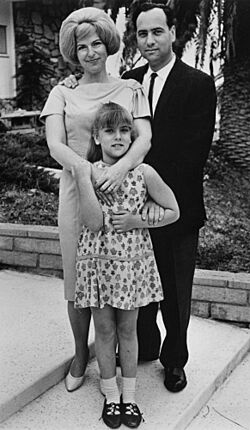Theodore Maiman facts for kids
Quick facts for kids
Theodore Maiman
|
|
|---|---|
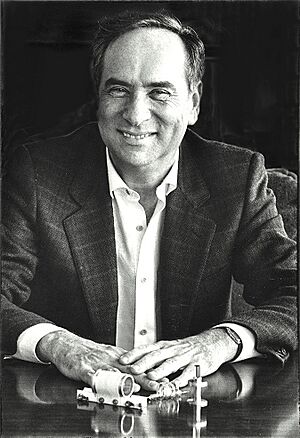
Maiman with the world's first laser in 1985
|
|
| Born |
Theodore Harold Maiman
July 11, 1927 Los Angeles, California, U.S.
|
| Died | May 5, 2007 (aged 79) Vancouver, British Columbia, Canada
|
| Alma mater | |
| Known for | Inventing the laser |
| Awards |
|
| Scientific career | |
| Fields | Physics, electrical engineering |
| Institutions |
|
| Thesis | Microwave-optical investigation of the 3³P fine structure in helium (1955) |
| Doctoral advisor | Willis Lamb |
Theodore Harold Maiman (born July 11, 1927 – died May 5, 2007) was an American engineer and physicist. He is famous for inventing the laser. Maiman's laser was the first of its kind. It led to the creation of many other types of lasers. He successfully made the laser work on May 16, 1960. Maiman and his employer, Hughes Aircraft Company, announced this amazing invention to the world on July 7, 1960. He received a patent for his laser and earned many awards for his important work.
Contents
Early Life and Education
Theodore Maiman was born in Los Angeles, California. His father, Abraham "Abe" Maiman, was an electrical engineer and inventor. When Theodore was young, his family moved to Denver, Colorado. There, he often helped his father with experiments in their home electronics lab.
Maiman said he was a very active child. As a teenager, he earned money by fixing electric appliances and radios. After high school, at age 17, he worked as a junior engineer. This was at the National Union Radio Company.
After serving in the United States Navy at the end of World War II, Maiman went to college. He earned a degree in engineering physics from the University of Colorado Boulder. He then continued his studies at Stanford University. He received a master's degree in electrical engineering in 1951. In 1955, he earned his PhD in physics.
For his PhD, Maiman studied tiny details of helium atoms. He also designed special lab equipment for these experiments. This research was very important. It helped him later when he was inventing the laser.
Inventing the Laser
In 1956, Maiman started working at the Hughes Aircraft Company. This company later became HRL Laboratories. He worked on a project to make a device called a maser much smaller. He successfully made it go from 2.5 tons to just 4 pounds. This project helped him learn a lot about light and energy.
Because of his success, Maiman convinced Hughes management to support his new idea. He wanted to build a laser. Many other scientists thought his idea, using a synthetic ruby crystal, would not work. But Maiman believed in his design.
On May 16, 1960, Maiman's hard work paid off. In the Hughes laboratories in Malibu, California, his laser worked! It was the world's first solid-state pink ruby laser. It produced coherent light. This means all the light rays were the same color and perfectly lined up.
Maiman wrote about his invention in the science magazine Nature on August 6, 1960. Other major research groups were also trying to build a laser. These included teams from IBM, Bell Labs, and MIT.
Maiman had thought about a solid-state laser even before his maser project. He needed to find the right material and a way to power it. Other scientists, like Arthur L. Schawlow and Charles H. Townes, suggested using gases. But Maiman found problems with their ideas. He decided to stick with his own plan. He believed a pink ruby crystal would work.
His successful design used a special pink ruby crystal. This crystal was made by the Linde Division of Union Carbide. He used a bright xenon flash lamp to power it. Maiman knew he had succeeded when the ruby crystal produced light that was 50 times brighter.
After the Invention
After inventing the laser, Maiman left Hughes in 1961. He joined a new company called Quantatron. This company grew its own ruby crystals for lasers. Maiman became a vice president there. He hired many of his old colleagues from Hughes. They started a special plant to grow synthetic rubies.
By 1962, Maiman had hired 35 people for his lab at Quantatron. When the company faced money problems, Maiman found a new partner in Union Carbide. In 1962, Maiman started his own company, Korad Corporation. Korad made powerful ruby lasers.
Maiman received US Patent Number 3,353,115 for his "Ruby Laser Systems" in 1967. Hughes Aircraft Company owned the patent. It became their most profitable patent.
In 1971, Maiman started Laser Video Corporation. He also worked at TRW Electronics from 1976 to 1983. He continued to be involved in laser development and uses. He held many patents for different laser technologies.
Before he passed away, Maiman taught at Simon Fraser University. He helped create courses about light and engineering.
Awards and Honors
Maiman received many awards for inventing the first laser. He became a member of the National Academy of Sciences and the National Academy of Engineering. He was also a Fellow of important groups like the American Physical Society and the Optical Society of America. In 1962, he won the Franklin Institute's Stuart Ballantine Medal.
In 1966, Maiman received the Oliver E. Buckley Condensed Matter Prize. President Lyndon B. Johnson presented him with another award at the White House. In 1976, he won the R.W. Wood Prize for his "Pioneer Development of the First Laser." He was also inducted into the National Inventors Hall of Fame in 1983. In 1987, he received the prestigious Japan Prize.
In 1994, he became an honorary fellow of the Royal College of Surgeons of England. This was special because he was not a doctor or royalty. Time magazine called Maiman's laser invention one of the 20 most important technologies of the 20th century. Many universities gave him honorary degrees.
Even after his death, Maiman's work continued to be honored. In 2007, Charles H. Townes, who helped invent the maser, said Maiman's article in Nature was "probably more important per word than any of the papers published by Nature over the past century." An annual student paper competition was named after him. In 2010, many events celebrated the 50th anniversary of Maiman's first laser.
The U.S. Congress passed a resolution honoring the laser's invention and Maiman. His achievement was also recognized as an IEEE Milestone. In 2017, UNESCO declared May 16 the International Day of Light. This day celebrates Maiman's first successful laser firing.
Death
Theodore Maiman passed away on May 5, 2007. He died from a rare illness called systemic mastocytosis. He was living in Vancouver, British Columbia, Canada, with his second wife, Kathleen. He had one daughter, Sheri, from his first marriage to Shirley. Sheri Maiman died of cancer in 1988 at the age of 30.
See also


